Dalbergia melanoxylon
Dalbergia melanoxylon Guill. & Perr.
Family: Fabaceae
Common names: zebra wood, African blackwood, African ebony (Eng.), sebrahout, swartdriedoring, driedoringebbehout (Afr.), isparati, mpingo (Swati), mogôrôgôrô (Northern Sotho), xilutsi, shipalats, xipalatsi (Tsonga), muuluri (Venda), mokgêlete (Tsw), umphhingo (Zul.)
Introduction
A beautiful, small, spiny tree, with fragrant, white, pea-like flowers in dense clusters in early summer; it also produces attractive purple-black heartwood that can be used to make musical instruments

Description
Description
Dalbergia melanoxylon is a small, spiny, deciduous tree, which grows 5 to 7 m tall. It is often multi-stemmed and much-branched, forming a low, irregularly shaped crown.
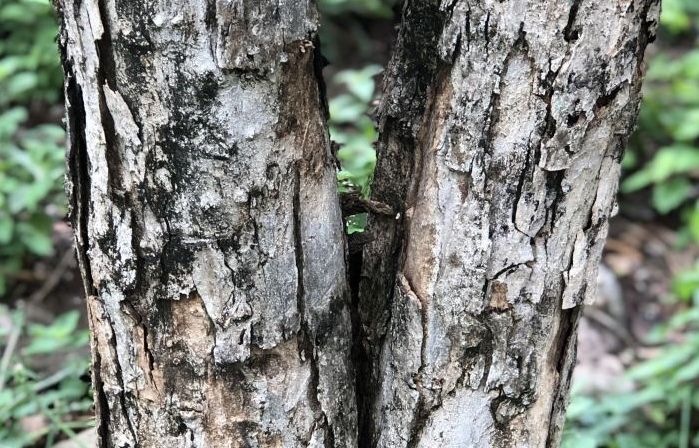
The bark is pale grey, smooth, but becoming rough and flaking with age.
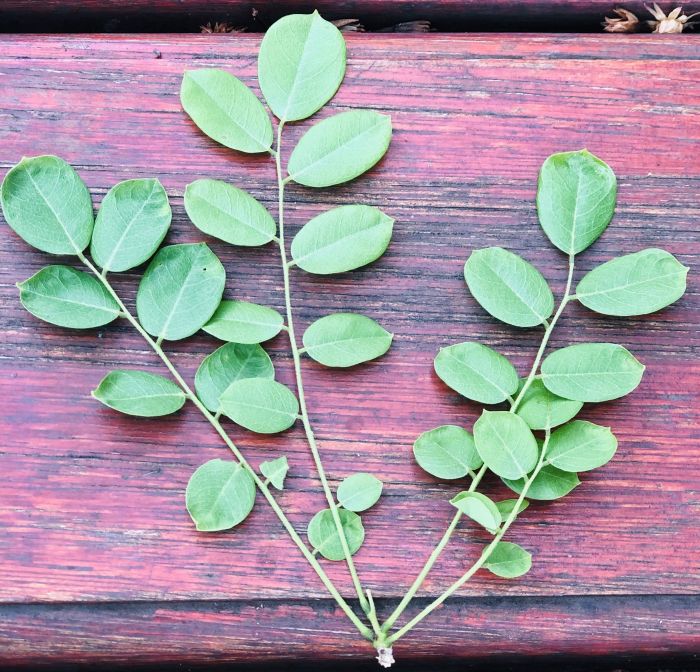
Branches are clustered at the nodes. Leaves are compound (imparipinnate); leaflets are oval, clustered on small branches.

Flowers are very small, white, pea-shaped, sweetly scented, produced in branched clusters arising at nodes along the branches, in early summer (from October to December).
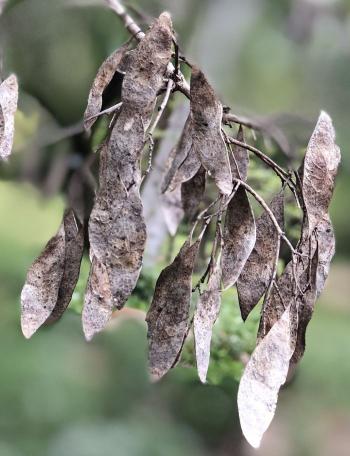
Fruit is a small, brown to khaki-coloured, flattened, thin, papery pod, not splitting, with a slight swelling where there is a seed. Seeds are kidney-shaped.
Conservation Status
Status
This species is not threatened in South Africa and is evaluated as Least Concern (LC) on the Red List of South African plants. However, it is widely exploited for its timber in many parts of Africa, where it is declining, with severely fragmented populations, and is listed as Near Threatened (NT) by the IUCN Red List, with research needed.
Distribution and habitat
Distribution description
Dalbergia melanoxylon is distributed in South Africa (where it occurs in the provinces of Limpopo and Mpumalanga), Swaziland, Botswana and Namibia, northwards to Senegal and eastwards to Eritrea, Ethiopia and Kenya. It grows in mixed woodland, thicket, bushveld, on rocky outcrops or termite mounds. This tree is found as an understorey tree in open miombo woodland dominated by species of Brachystegia, Julbernardia and Isoberlinia, but is most common near water.
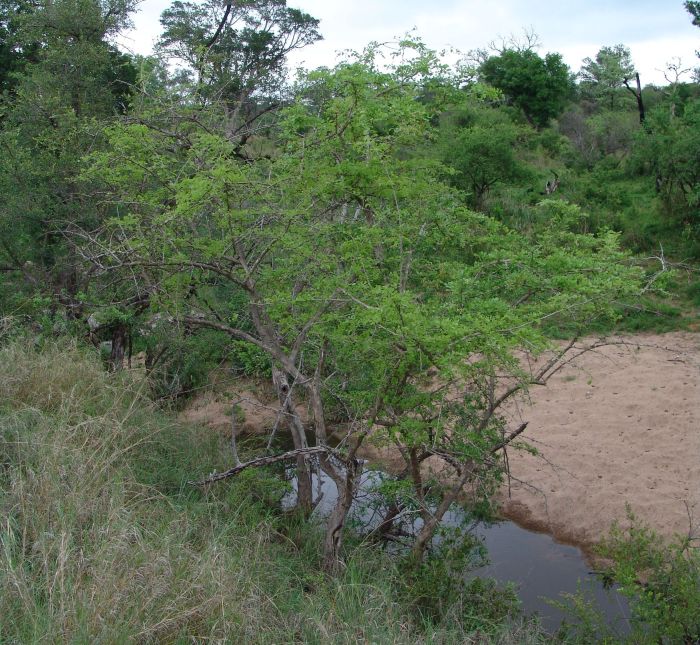
Derivation of name and historical aspects
History
The generic name Dalbergia honours the Swedish brothers Nils and Carl Dalberg, botanists who lived in the eighteenth century. The specific name is Greek and means ‘dark wood’.
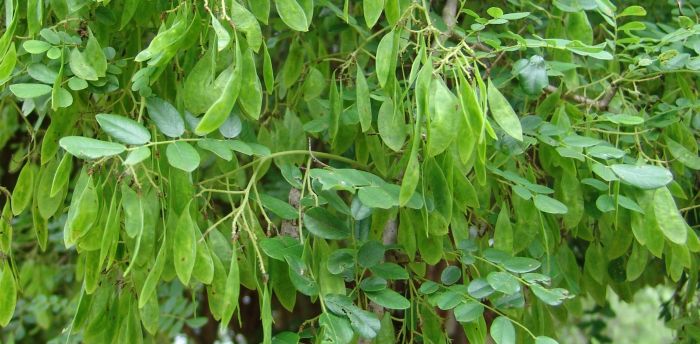
Ecology
Ecology
Dalbergia melanoxylon is pollinated by bees. Flowers are a good source of nectar for honey bees. The fruits and foliage are browsed by game and livestock, except horses. It is a plant of low to moderate elevations and it grows in areas where the mean annual temperature is in the range 18–35ºC and the mean annual rain fall is 700–1 200 mm. It is found near water or in valleys of impeded drainage. It grows very well in sandy, loam and clay soils. This plant is extremely slow growing. Mature trees are fire tolerant and young seedlings are harmed by fire.

Uses
Use
Dalbergia melanoxylon is traditionally used to treat diarrhoea, headache, bronchitis and colds, rheumatism, prevent miscarriage, treat gonorrhoea, stomachache and abdominal pain, to clean wounds, relieve pain in joints and to treat inflammation in mouth and throat.
African Blackwood is heavy, dense, very hard and very durable, and one of the most valuable timbers in Africa. Its black heartwood has been highly prized since ancient times and used for carving and to make artefacts. It is particularly in demand for making wind-instruments and parts of violins. The sapwood is yellowish white, and makes an eye-catching contrast with the black heartwood. It is sold in small volumes, but at high prices. In South Africa, the timber is used to manufacture musical instruments, fine furniture, walking sticks and knife handles. The wood is also used as a fuel and to make charcoal.
The leaves and pods provide good mulch and the roots of these trees may improve the soil by nitrogen fixation. They can be used to prevent soil erosion because of its extensive root system. Trees provide shelter and make useful windbreaks and live fences.

Growing Dalbergia melanoxylon
Grow
Propagation of this species can be achieved by seeds, cuttings and suckers. Seeds must be collected when they are brown, cleaned by removing the papery pod and sown when they are still fresh, without pre-treatment, in a seed tray filled with a well-drained sowing medium (e.g. 3 parts potting soil and 1 part river sand), in summer. The seed tray should be placed on a raised bench, in a warm area covered with a net, until germination. The soil should be kept moist all the time, but not wet. Germination can be expected after 8 days.
Grow this tree in a sunny position, in clayey soil with water in summer. Trees are slow growing, although the plant may reach about 3 m in 10 years; They take up to 100 years to produce a trunk with enough heartwood worth harvesting.
References
- Foden, W. & Potter, L. 2005. Dalbergia melanoxylon Guill. & Perr. National Assessment: Red List of South African Plants version 2017.1. Accessed on 2019/12/02
- Lemmens, R.H.M.J., 2008. Dalbergia melanoxylon Guill. & Perr. In: Louppe, D., Oteng-Amoako, A.A. & Brink, M. (Eds). PROTA, Wageningen, Netherlands. https//uses.plantnet.org.en/Dalbergia –melanoxylon-(PROTA). Accessed 18 November 2019.
- Schmidt, E., Lötter, M. & McCleland, W. 2002. Trees and shrubs of Mpumalanga and Kruger National Park. Jacana, Johannesburg.
- Van Wyk, B. & Van Wyk, P. 1997. Field guide to trees of southern Africa. Struik, Cape Town.
- World Conservation Monitoring Centre 1998. Dalbergia melanoxylon. The IUCN Red List of Threatened Species 1998: e.T32504A9710439. http://dx.doi.org/10.2305/IUCN.UK.1998.RLTS.T32504A9710439.en. Downloaded 2 December 2019.
Credits
Winfred Velephi Ngwenya
Lowveld National Botanical Garden
December 2019
Plant Attributes:
Plant Type: Shrub, Tree
SA Distribution: Limpopo, Mpumalanga
Soil type: Sandy, Clay, Loam
Flowering season: Early Summer
PH:
Flower colour: White, Cream
Aspect: Full Sun
Gardening skill: Easy
Special Features:
Horticultural zones








Rate this article
Article well written and informative
Rate this plant
Is this an interesting plant?
Login to add your Comment
Back to topNot registered yet? Click here to register.